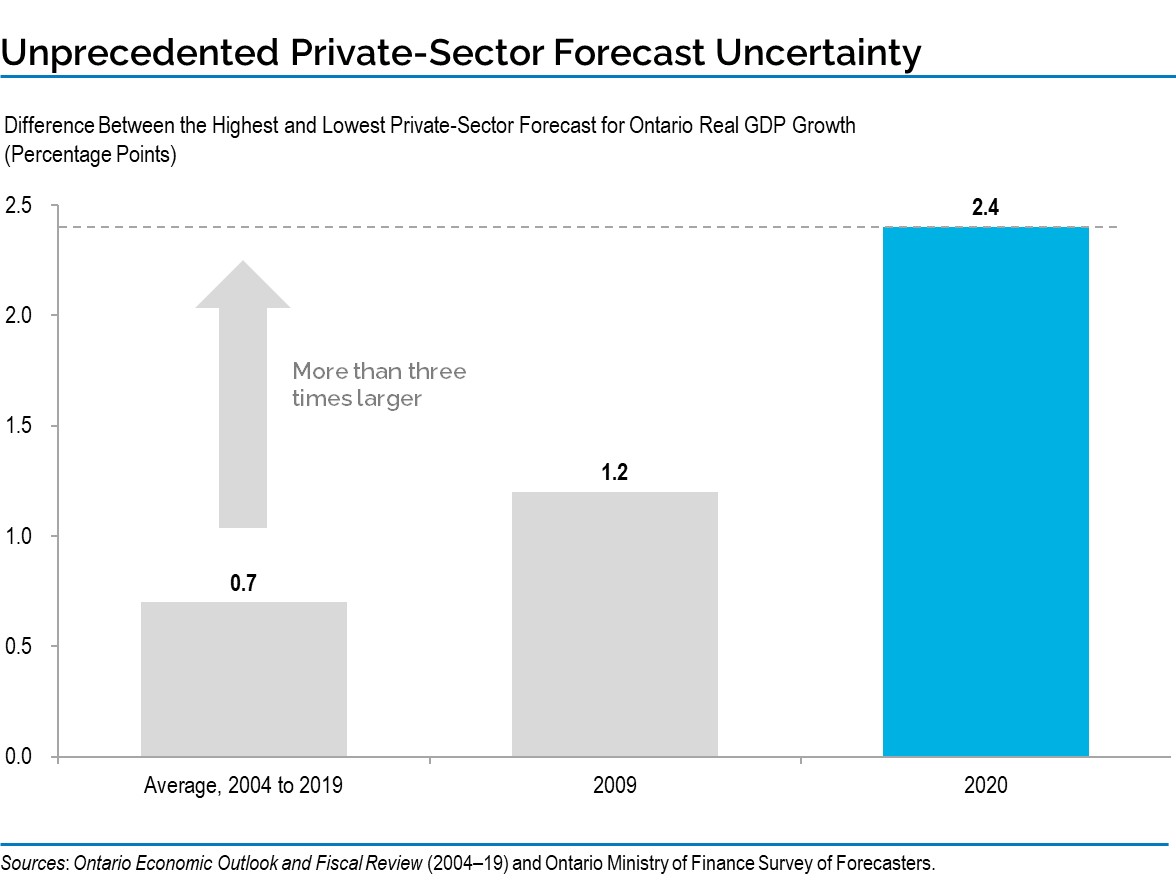The COVID‑19 pandemic is having unprecedented impacts around the world, including here in Ontario. People came together to get through the first wave of the global pandemic and this same Ontario Spirit will sustain them as the province faces the second wave. Building on the Province’s immediate and effective response at the onset of the global pandemic, the next phase of Ontario’s Action Plan: Protect, Support, Recover will create stability for people and businesses, provide the necessary flexibility and resources to respond to future waves of the virus, and begin building the foundation for Ontario’s strong long-term economic growth.
Planning for uncertainties
Since the beginning of the COVID‑19 outbreak, the Ontario government has promised to do whatever is necessary to protect the people of Ontario from COVID‑19 and provide support for people and jobs as the crisis evolves. The government remains unwavering in that commitment and continues to invest in the fight against COVID‑19. Ontario is supporting frontline health care workers and helping hospitals, long-term care homes, public health units and other health care providers respond to COVID‑19 and protect patients and vulnerable populations, while also budgeting for necessary contingencies.
The government has made available targeted, time-limited contingency funding of $13.3 billion (of which $2.6 billion remains) in 2020–21, $5 billion in 2021–22 and $2.8 billion in 2022–23 to address the extraordinary, emerging needs of the health care system, and to support people and jobs during this unprecedented global pandemic. This flexible approach ensures funding is available for critical services and programs such as health care and education to appropriately respond to rapidly changing circumstances as needed. This flexibility was crucial to navigating the first wave and will remain critical going forward.
The COVID‑19 pandemic has significantly impacted Ontario’s economy. Ontario’s employment decreased by 15.3 per cent between February and May 2020, a far sharper decline than past major recessions. Thanks to the responsible behaviour of people, as well as prudent and timely measures by all levels of government, key economic indicators have improved significantly following historic declines earlier in the year.
An extraordinary degree of uncertainty remains in the economic outlook as it will be heavily influenced by the evolution of the COVID‑19 pandemic. Uncertainty regarding the state of the economy has contributed to the largest range in private-sector forecasts in recent history of 2.4 percentage points between the lowest and highest real GDP growth forecast for 2020. In keeping with the government’s commitment to providing maximum transparency and accountability, the 2020 Budget outlines alternative economic scenarios that illustrate potential implications for the Province’s finances.

Managing Ontario’s finances responsibly
The government has charted a prudent course that provides the necessary resources to deal with COVID‑19 while continuing Ontario’s leadership in being transparent and accountable about the province’s finances. In March, Ontario was the first in Canada to release a fiscal outlook that reflected the impacts of the COVID‑19 crisis. To further build on the government’s record of transparency, the 2020 Budget includes a multi-year fiscal plan with two alternative scenarios to ensure the people of Ontario are informed about the potential implications of the unprecedented economic uncertainty for the province’s finances.
The government is projecting a deficit of $38.5 billion in 2020–21, unchanged from the deficit forecast at the time of the 2020–21 First Quarter Finances update. Over the medium term, the government projects steadily declining deficits of $33.1 billion in 2021–22, and $28.2 billion in 2022–23. This incorporates the most up to date economic information and includes new additional supports for the pandemic response and recovery.
Total revenue is projected to be $151.1 billion in 2020–21, $462 million higher than in the 2020–21 First Quarter Finances update, mainly due to higher Government of Canada transfers. Program expenses are projected to be $174.6 billion in 2020–21, $394 million higher, primarily due to additional supports for people during the pandemic.
While COVID‑19 will impact Ontario and the entire world for the foreseeable future, Ontario’s 2020 Budget begins to build the foundation for a strong economic recovery fuelled by growth. Acknowledging the continued uncertainty of the global pandemic, the government plans to table a multi-year plan including a path to balance in the 2021 Budget by March 31, 2021.
Accessible description of Chart
Chart: Employment Change Compared to Previous Major Downturns
The line chart shows the Ontario employment change from peak employment by month for the last three recessions (1981‑82, 1990‑92, 2008‑09) and in 2020. During the 1981–82 recession, employment hit its low point in (post-peak) month 13 at −4.8 per cent and returned to peak employment in month 24. During the 1990‑92 recession, employment hit its low point in month 31 at −6.9 per cent and returned to peak employment in month 88. During the 2008–09 recession, employment hit its low point in month eight at −4.1 per cent and returned to peak employment in month 30. In the 2020 recession, employment hit its low point of −15.3 per cent in May.
There is a box labelled 2020 Recession with details of the employment change since February 2020. From February to May, employment was down 1,156,500 net jobs or 15.3 per cent and from May to September, employment was up 838,000 net jobs or 11.1 per cent. Overall employment from February to September was down 318,500 net jobs or 4.2 per cent.
Sources: Statistics Canada and Ontario Ministry of Finance.